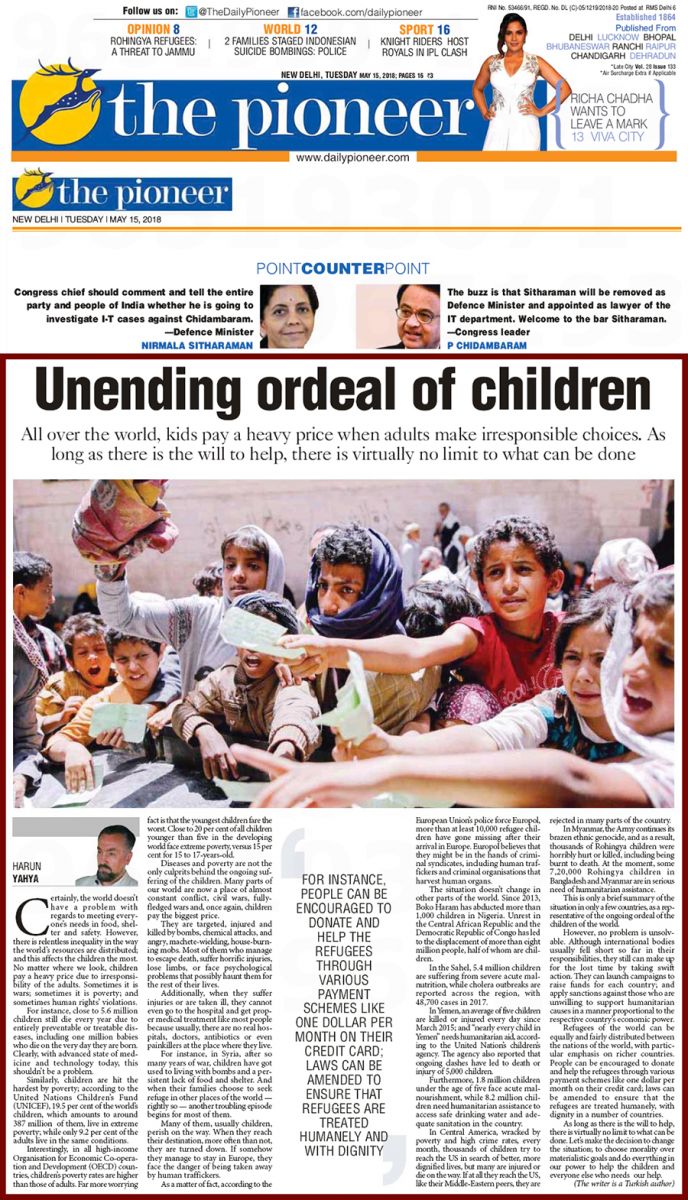
All over the world, kids pay a heavy price when adults make irresponsible choices. As long as there is the will to help, there is virtually no limit to what can be done
Certainly, the world doesn’t have a problem with regards to meeting everyone’s needs in food, shelter and safety. However, there is relentless inequality in the way the world’s resources are distributed; and this affects the children the most. No matter where we look, children pay a heavy price due to irresponsibility of the adults. Sometimes it is wars; sometimes it is poverty; and sometimes human rights’ violations.
For instance, close to 5.6 million children still die every year due to entirely preventable or treatable diseases, including one million babies who die on the very day they are born. Clearly, with advanced state of medicine and technology today, this shouldn’t be a problem.
Similarly, children are hit the hardest by poverty; according to the United Nations Children’s Fund (UNICEF), 19.5 per cent of the world’s children, which amounts to around 387 million of them, live in extreme poverty; while only 9.2 per cent of the adults live in the same conditions.
Interestingly, in all high-income Organisation for Economic Co-operation and Development (OECD) countries, children’s poverty rates are higher than those of adults. Far more worrying fact is that the youngest children fare the worst. Close to 20 per cent of all children younger than five in the developing world face extreme poverty, versus 15 per cent for 15 to 17-years-old.
Diseases and poverty are not the only culprits behind the ongoing suffering of the children. Many parts of our world are now a place of almost constant conflict, civil wars, fully-fledged wars and, once again, children pay the biggest price.
They are targeted, injured and killed by bombs, chemical attacks, and angry, machete-wielding, house-burning mobs. Most of them who manage to escape death, suffer horrific injuries, lose limbs, or face psychological problems that possibly haunt them for the rest of their lives.
Additionally, when they suffer injuries or are taken ill, they cannot even go to the hospital and get proper medical treatment like most people because usually, there are no real hospitals, doctors, antibiotics or even painkillers at the place where they live.
For instance, in Syria, after so many years of war, children have got used to living with bombs and a persistent lack of food and shelter. And when their families choose to seek refuge in other places of the world — rightly so — another troubling episode begins for most of them.
Many of them, usually children, perish on the way. When they reach their destination, more often than not, they are turned down. If somehow they manage to stay in Europe, they face the danger of being taken away by human traffickers.
As a matter of fact, according to the European Union’s police force Europol, more than at least 10,000 refugee children have gone missing after their arrival in Europe. Europol believes that they might be in the hands of criminal syndicates, including human traffickers and criminal organisations that harvest human organs.
The situation doesn’t change in other parts of the world. Since 2013, Boko Haram has abducted more than 1,000 children in Nigeria. Unrest in the Central African Republic and the Democratic Republic of Congo has led to the displacement of more than eight million people, half of whom are children.
In the Sahel, 5.4 million children are suffering from severe acute malnutrition, while cholera outbreaks are reported across the region, with 48,700 cases in 2017.
In Yemen, an average of five children are killed or injured every day since March 2015; and “nearly every child in Yemen” needs humanitarian aid, according to the United Nation’s children’s agency. The agency also reported that ongoing clashes have led to death or injury of 5,000 children.
Furthermore, 1.8 million children under the age of five face acute malnourishment, while 8.2 million children need humanitarian assistance to access safe drinking water and adequate sanitation in the country.
In Central America, wracked by poverty and high crime rates, every month, thousands of children try to reach the US in search of better, more dignified lives, but many are injured or die on the way. If at all they reach the US, like their Middle-Eastern peers, they are rejected in many parts of the country.
In Myanmar, the Army continues its brazen ethnic genocide, and as a result, thousands of Rohingya children were horribly hurt or killed, including being burnt to death. At the moment, some 7,20,000 Rohingya children in Bangladesh and Myanmar are in serious need of humanitarian assistance.
This is only a brief summary of the situation in only a few countries, as a representative of the ongoing ordeal of the children of the world.
However, no problem is unsolvable. Although international bodies usually fell short so far in their responsibilities, they still can make up for the lost time by taking swift action. They can launch campaigns to raise funds for each country; and apply sanctions against those who are unwilling to support humanitarian causes in a manner proportional to the respective country’s economic power.
Refugees of the world can be equally and fairly distributed between the nations of the world, with particular emphasis on richer countries. People can be encouraged to donate and help the refugees through various payment schemes like one dollar per month on their credit card; laws can be amended to ensure that the refugees are treated humanely, with dignity in a number of countries.
As long as there is the will to help, there is virtually no limit to what can be done. Let’s make the decision to change the situation; to choose morality over materialistic goals and do everything in our power to help the children and everyone else who needs our help.
0 comments:
Post a Comment